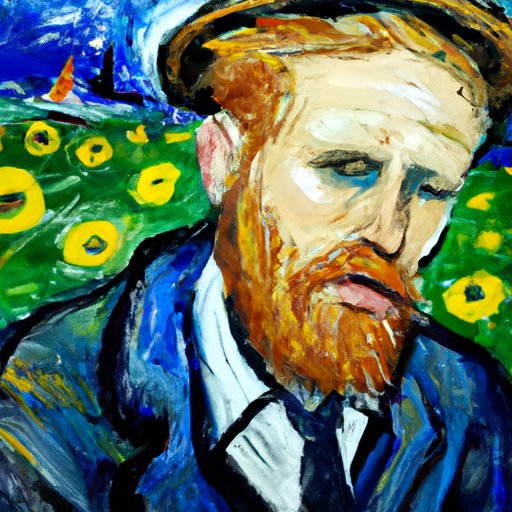Introduction
Vincent van Gogh is one of the most recognizable artists in the world. His expressive use of color and bold brushstrokes have made him an icon of Post-Impressionism, with works like The Starry Night and Sunflowers remaining timeless classics. But who was Vincent van Gogh? And what makes his artwork so remarkable? This article will explore the life and art of the Dutch master, examining the themes and styles that make his work so beloved.
Biographical Sketch of the Life and Art of Vincent van Gogh
Vincent Willem van Gogh was born in the Netherlands in 1853. He was the eldest son of a minister and had six siblings. As a child, van Gogh was deeply religious and developed an interest in art from an early age. He studied art in Amsterdam but failed to find success, eventually leaving for Paris in 1886.
In Paris, van Gogh was exposed to the world of Impressionism, which would go on to influence his own artwork. He befriended fellow painters such as Paul Gauguin and Emile Bernard, and during this period he produced hundreds of paintings. In 1888, he moved to Arles in the south of France, where he created some of his most iconic works. Sadly, his mental health deteriorated in the late 1880s and he was admitted to a mental asylum in Saint-Rémy-de-Provence in 1889.
Van Gogh eventually moved to Auvers-sur-Oise in 1890 and created more than 70 paintings in the last two months of his life. He died in July of that year, at the age of 37.
Exploring the Themes and Styles of Van Gogh’s Art
Van Gogh’s artwork was heavily influenced by Impressionism, with its vivid colors and thick brushstrokes. He often used dark blues and greens to convey emotion and light oranges and yellows to evoke warmth and energy. His paintings were often characterized by vibrant swirls of paint, creating a sense of movement and energy.
The subjects of van Gogh’s paintings were often landscapes, still lifes, and self-portraits. He often painted scenes of nature, such as wheat fields and cypress trees. He also frequently depicted peasant life, capturing the hardship and resilience of rural communities.
In his later years, van Gogh began to focus on inner contemplation and emotion. His works became more abstract, with depictions of feelings and spiritual states. He sought to capture the essence of his subjects, rather than merely the physical form.
How van Gogh’s Mental Health Influenced His Art
Van Gogh suffered from mental illness throughout his life, including depression and anxiety. In 1889, he was diagnosed with epilepsy and admitted to a mental asylum in Saint-Rémy-de-Provence. During his time there, he continued to produce artwork. Many of his works from this period featured swirling, agitated brushwork, reflecting his inner turmoil.
Van Gogh’s mental health had a profound impact on his artwork. His use of color and brushstrokes became more intense and expressive, reflecting his emotional state. His works often contained references to his struggles, such as his series of self-portraits depicting his mental anguish.
Examining the Influence of Impressionism on van Gogh’s Art
Van Gogh’s artwork was heavily influenced by the Impressionists. He adopted their use of vivid colors and visible brushstrokes to create dynamic, emotive images. He was particularly inspired by the works of Claude Monet and Paul Cézanne, both of whom he admired greatly.
Van Gogh was also influenced by the Impressionists’ focus on capturing light and movement. He sought to capture moments of transition, such as sunsets and storms. His works often featured turbulent skies and shimmering stars, conveying a sense of awe and wonder.
A Look at van Gogh’s Place in Art History
During his lifetime, van Gogh was relatively unknown, selling only one painting during his lifetime. However, his works soon gained recognition and are now among the most famous and beloved paintings in the world. His works have been celebrated for their vivid colors, expressive brushwork, and contemplative themes.
Today, van Gogh is widely regarded as one of the greatest artists of all time. His paintings are held in museums around the world and his legacy continues to inspire generations of artists.
Conclusion
Vincent van Gogh was a remarkable artist whose works continue to captivate audiences today. His artwork was heavily influenced by Impressionism, with its vivid colors and expressive brushstrokes. He often depicted nature, peasant life, and his own inner emotions, creating powerful, emotive images. His mental health struggles also played a significant role in his artwork, with his later works often reflecting his inner turmoil. Finally, it is impossible to ignore van Gogh’s place in art history. His works remain timeless classics and his legacy will continue to inspire future generations of artists.
(Note: Is this article not meeting your expectations? Do you have knowledge or insights to share? Unlock new opportunities and expand your reach by joining our authors team. Click Registration to join us and share your expertise with our readers.)
